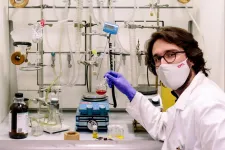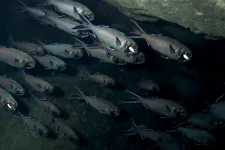Intelligent insect counter opens new opportunities for nature monitoring
Engineers and biologists from Aarhus University have developed an intelligent light trap that can count insects and determine their species as they fly past; this could significantly boost nature monitoring
2021-03-19
(Press-News.org) 3,938 moths are part of a major insect study based on artificial intelligence, and researchers from Aarhus University have just published their results in the scientific journal Sensors.
They have developed a counting machine that uses ultraviolet light to attract insects and register them with image recognition. The invention may have a decisive impact on research into climate change and biodiversity.
"If we can monitor the development of moth populations, we can gain new knowledge about how climate change affects our nature. Our technology takes an important step towards automating the very extensive work entailed in counting insects," says Kim Bjerge, associate professor at the Department of Electrical and Computer Engineering at Aarhus University.
Moths are some of our most important markers for climate change, and they are important for global biodiversity. For this reason, biologists are currently spending thousands of hours manually counting moths to monitor developments in the population.
A moth is not just a moth
The challenge is that a moth is not just a moth. There are more than 2,400 different species in Denmark alone, which makes counting and species determination a difficult and time-consuming task.
Today, we catch moths in light traps with a special type of poison. Then we take the dead insects to the laboratory and study them one by one under a microscope.
"Determining the species of moths is a highly specialised task. Our machine can replace much of the manual work, so we can do much larger studies than is possible today. We also avoid having to kill the insects," says Kim Bjerge.
The machine registers the flying insects with a camera which, by means of an algorithm, not only counts the insects, but also determines the species in an instant.
It sounds simple, but there is a lot of interdisciplinary research work behind the insect counter and the artificial intelligence, says Kim Bjerge.
"The biggest challenge has been to train the neural network to recognise a single moth out of several thousand different species and to ensure that it's not counted more than once if it flies past again. Of course, it's absolutely crucial that the technology can be used to monitor the populations of individual species," he says.
The researchers have trained the algorithm in the insect counters with images of moths that have already been species-determined by entomologists.
Intelligent nature monitoring
The intelligent insect counter could pave the way for a completely new form of nature monitoring. Therefore, the researchers in Aarhus are very excited that a large number of international research groups have already shown an interest in implementing the technology as part of their national biodiversity initiatives.
"There are major perspectives in using artificial intelligence to monitor insects. We can study the species without killing one single insect, while at the same time gaining more precise knowledge about their habitats, population status and level of activity from day to day," says Toke Thomas Høye, senior researcher from the Department of Bioscience.
He is the ideas man behind the counter and he will use it in his own research work to monitor how quickly different species of moth are attracted by nature restoration projects.
"We hope that the technology will make it possible for us to monitor moths more systematically. This will help us discover whether some species are disappearing. Moths constitute an important element in the Earth's ecosystems. They perform important functions such as pollination, and they're generally good indicators of the state of nature," he says.
INFORMATION:
ELSE PRESS RELEASES FROM THIS DATE:
2021-03-19
We all feel physical pain in different ways, but people with nerve injuries often have a dysfunctional pain suppression system, making them particularly prone to discomfort.
Now researchers have uncovered that virtual reality (VR) can reduce types of pain typically seen in patients with nerve injuries - and that VR can boost the dysfunctional pain suppression system, giving people with chronic pain a possible game-changing hope.
Dr Sam Hughes, Lecturer in Psychology at the University of Plymouth, led the study focusing on conditioned pain modulation ...
2021-03-19
In 1991, scientists Brian O'Regan and Michael Grätzel at EPFL published a seminal paper describing a new type of solar cell: the dye-sensitized solar cell (DSSC), also known as "Grätzel cell". Simple and cheap to build while being flexible and versatile, DSSCs are already manufactured on a multi-megawatt scale, cutting a significant slice of the photovoltaic market, which currently supplies almost 3% of all the world's electricity, well in the race to reduce carbon emissions.
Now, Dan Zhang and Marko Stojanovic, two PhD students in Grätzel's lab at EPFL's School of Basic Sciences, have led the development of a simple dye for DSSCs, called MS5. In devices, this new sensitizer can either be used as single dye, ...
2021-03-19
Researchers from Tomsk Polytechnic University jointly with their colleagues from the Czech Republic have found a method to synthesize cyclic carbonates from atmospheric CO2. Cyclic carbonates are organic compounds, used as electrolytes for lithium-ion batteries, green solvents as well as in pharmaceutical drugs manufacturing. The scientists managed to synthetize carbonates under sunlight and at room temperature, while conventional methods require synthesis under high pressure and temperatures. The research findings are published in Journal of Materials Chemistry A (IF:11,301; Q1).
"The increase in CO2 levels in the atmosphere is a global environmental problem. The solutions of the problem are usually focused on measures to reduce CO2 emissions. An alternative method is to use the CO2 already ...
2021-03-19
Flashlight fish have the ability to generate situation-specific blink patterns resembling a visual Morse code. Researchers at Ruhr-Universität Bochum have shown in laboratory and field experiments that the animals use these light signals to coordinate their behaviour in the school when visibility is limited. Both the light intensity and the blinking frequency affected the animals' behaviour. The team headed by Peter Jägers and Professor Stefan Herlitze from the Department of General Zoology and Neurobiology has shared their findings in the journal Scientific Reports, published online on 19 ...
2021-03-19
COLUMBUS, Ohio - Recent generations show a worrying decline in health compared to their parents and grandparents when they were the same age, a new national study reveals.
Researchers found that, compared to previous generations, members of Generation X and Generation Y showed poorer physical health, higher levels of unhealthy behaviors such as alcohol use and smoking, and more depression and anxiety.
The results suggest the likelihood of higher levels of diseases and more deaths in younger generations than we have seen in the past, said Hui Zheng, ...
2021-03-19
Most drugs operate via the membranes that surround the body's cells. A study by researchers at Karolinska Institutet in Sweden has now mapped the structure and mechanism of MGST2, a membrane enzyme that, amongst other things, plays a part in chronic inflammation and cancer. The study, which is published in the journal Nature Communications, can make a significant contribution to the development of future drugs.
All our cells are enclosed in a fat-rich membrane. The cells' equivalent to organs, the organelles, are also enclosed by membranes. Embedded in the cell's internal and external membranes are proteins that regulate a large number of vital functions. ...
2021-03-19
Parkinson's disease is the second most common, age-related, neurodegenerative disease: In Germany alone, about 300,000 people are affected and experience sometimes major limitations to their quality of life. Although Parkinson's is so widespread, there is still no treatment that targets the cause of the disease and can stop it in its tracks.
However, current research provides new hope: A research team at the University of Konstanz led by Professor Marcus Groettrup describes a new approach for developing future treatments for Parkinson's. The biologists demonstrated that the ubiquitin-like ...
2021-03-19
Boston, Mass. - In a paper published in the Journal of General Internal Medicine, physician-researchers at Beth Israel Deaconess Medical Center (BIDMC) assessed the relative impact of COVID-19 on patients hospitalized with the viral infection in March and April 2020, versus patients hospitalized with influenza during the last five flu seasons at the medical center. Overall, the team demonstrated that COVID-19 cases resulted in significantly more weekly hospitalizations, more use of mechanical ventilation and higher mortality rates than influenza.
COVID-19 and influenza are both contagious respiratory viral diseases that can lead to pneumonia and acute respiratory failure in severe cases. However, detailed comparison of the epidemiology and clinical characteristics of COVID-19 ...
2021-03-19
Researchers at Aalto University and the Niilo Mäki Institute have used neuroimaging to pinpoint where the brain activates - or doesn't activate - among children identified as having a high risk of dyslexia. Magnetoencephalography (MEG) has rarely been used to study the reading disorder in children.
The brain study was carried out at Aalto University by measuring brain activity with MEG, which measures the weak magnetic fields arising from electrical activity in the brain, over a period of two days. Earlier studies have shown that difficulties in processing sounds may be partly responsible for dyslexia, and that these challenges may relate to the left auditory cortex which processes language.
During the study, the children listened to nonsensical ...
2021-03-19
At the start of Neurodiversity Celebration Week, new research from Cranfield University demonstrates the importance of organisations becoming more inclusive employers when it comes to neurodiversity.
It has been estimated that one in seven of the population of the UK is neurodiverse. However, according to research by the Institute of Leadership and Management, only half of managers would employ a neurodiverse person.
Last week, in an interview with The Times, The Second Sea Lord Vice Admiral Nick Hine, revealed that ten years ago he was diagnosed with autism.
Speaking to The Times, the Vice Admiral, said: ""The world is made for neuro-typical people by neuro-typical people, and therefore it's not surprising that people who are not neuro-typical have a ...
LAST 30 PRESS RELEASES:
[Press-News.org] Intelligent insect counter opens new opportunities for nature monitoring
Engineers and biologists from Aarhus University have developed an intelligent light trap that can count insects and determine their species as they fly past; this could significantly boost nature monitoring


